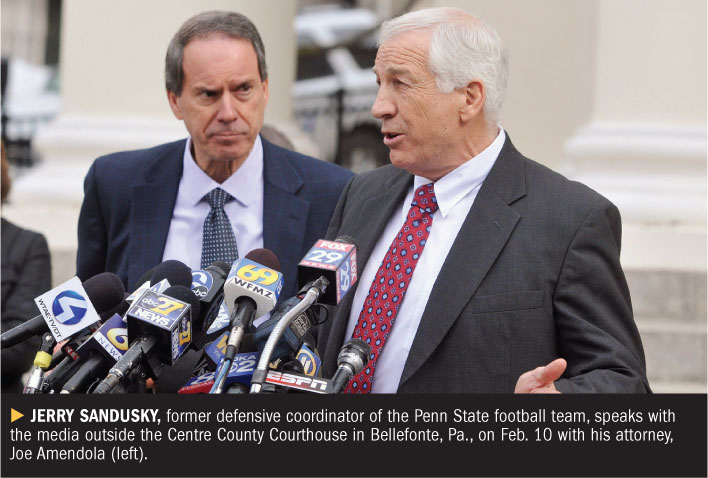 The allegations joining Penn State and its officials with the Jerry Sandusky sexual-abuse cases provide a regrettable study of how we turn to insurance to help us through the worst of situations—at least financially. As these allegations play out, the media has been quick to discuss their development and speculate on how the university's defense will be funded.
The allegations joining Penn State and its officials with the Jerry Sandusky sexual-abuse cases provide a regrettable study of how we turn to insurance to help us through the worst of situations—at least financially. As these allegations play out, the media has been quick to discuss their development and speculate on how the university's defense will be funded.
Penn State's Openness Web site, dedicated to providing “the latest information…regarding ongoing investigations,” reports that the university carries General Liability and D&O insurance, “which are expected to cover the defense of claims brought against the university and its officers, employees and trustees” in the Jerry Sandusky case. The General Liability carrier is identified as the Pennsylvania Manufacturers' Association (PMA), which has provided General Liability insurance for Penn State from the 1950s to the present.
Also mentioned on the Openness site is the fact that PMA filed a lawsuit in January asking that it be relieved of obligations to defend or pay for a civil lawsuit filed against Penn State in the first suit on the Sandusky matter. The PMA suit seeks a declaratory judgment releasing the company from having to pay costs to defend Penn State in a suit by John Doe A.
In reponse, Penn State has sued PMA for breach of contract for duty to defend, breach of contract for duty to indemnify, anticipatory breach of contract and bad faith. Much of the argument revolves around which GL policies will or will not be triggered by the Doe A lawsuit.
The university filed its liability claim under the 2004 PMA policy, contending a continuous-trigger theory. Penn State contends that it is entitled to a defense under each of the PMA policies that were in force during the period of the alleged continuing abuse.
Additionally, the university believes it is entitled to designate the policy that it wants to call up—namely, the 2004 policy.
To the contrary, PMA has indicated that it may provide coverage for the negligence allegations (and applicable defense) only under its 1991 policy, positing a theory that only the policy in effect at the time the alleged injury first commenced may apply. It has reportedly denied all coverage obligations from 1992 through the current policies.
The issues here are complicated—and the damages could be astronomical. It is impossible to predict how Penn State will fare in its battle with PMA. Keep in mind that PMA has insured Penn State's liability exposure continuously over the last 50-plus years.
But coverage is contractual in nature, and a number of issues will arise and be argued in addition to the question of which policy is triggered. Among these are exclusions that PMA notes in its reservation-of-rights letter:
- Potential intentional-act exclusion: Does this exclusion apply to the university and Sandusky (the alleged perpetrator) or only to Sandusky?
- The known-loss exclusion: Did Penn State really have knowledge, suspicions or neither?
- The insurability of punitive damages: Pennsylvania has permitted the insurability of punitive damages for vicarious liability. If Penn State is held vicariously liable here, would PMA find itself responsible for potential punitive damages? (This, of course, hinges on there being coverage in the first place.)
- The presence of an abuse/molestation exclusion on PMA's 1992 policy: The application of this exclusion hinges on the policy that is triggered (if one is). In addition, does the exclusion reach to the university or only to Sandusky?
Penn State has a rough course on this one, and the battle with PMA will be a long one. I imagine that the university's D&O insurer is more likely working with Penn State in dealing with various coverage scenarios. Stay tuned for some of the issues that we can speculate about under the D&O policy.
|Want to continue reading?
Become a Free PropertyCasualty360 Digital Reader
Your access to unlimited PropertyCasualty360 content isn’t changing.
Once you are an ALM digital member, you’ll receive:
- Breaking insurance news and analysis, on-site and via our newsletters and custom alerts
- Weekly Insurance Speak podcast featuring exclusive interviews with industry leaders
- Educational webcasts, white papers, and ebooks from industry thought leaders
- Critical converage of the employee benefits and financial advisory markets on our other ALM sites, BenefitsPRO and ThinkAdvisor
Already have an account? Sign In Now
© 2024 ALM Global, LLC, All Rights Reserved. Request academic re-use from www.copyright.com. All other uses, submit a request to [email protected]. For more information visit Asset & Logo Licensing.








